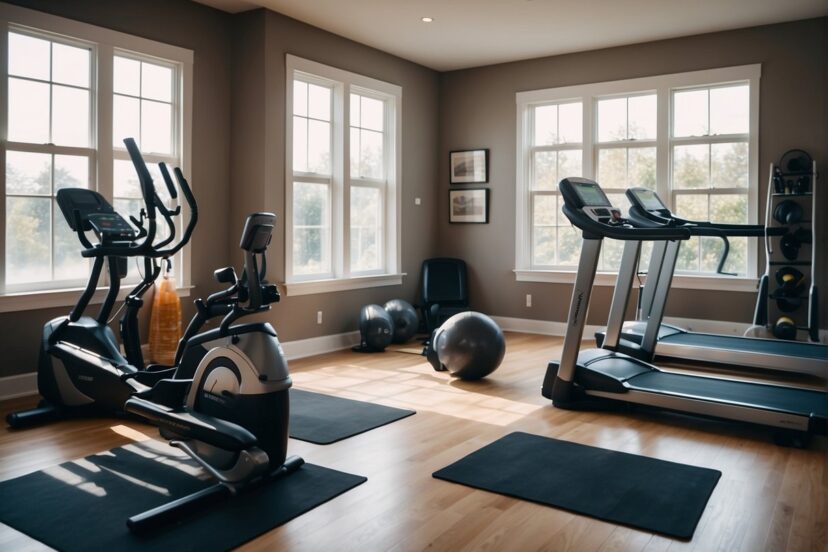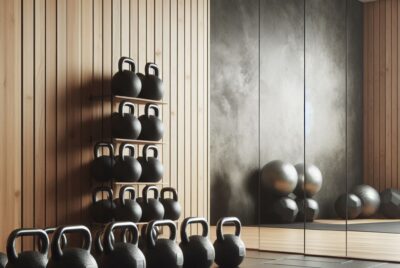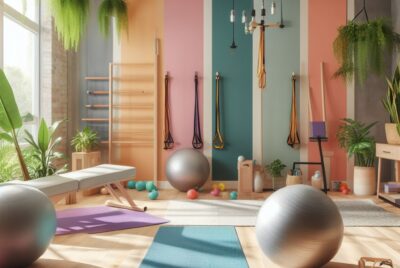Fit Home Gym: Your Perfect Workout Space
*We may earn a commission for purchases made using our links. Please see our disclosure to learn more.
Fit Home Gym Essentials: Creating Your Perfect Workout Space
In the realm of home exercise equipment, the fit home gym system has positioned itself as a versatile invention. Its patent-pending modular structure facilitates the creation of multiple exercise setups, which allows for an extensive range of workouts within the confines of one’s own home. As someone who values efficiency, I appreciate how the system accommodates exercises such as pull-ups, push-ups, and dips. Its design mirrors the adaptability required by contemporary fitness enthusiasts, eliminating the need for multiple pieces of equipment that typically consume valuable space.

Ease of use is at the forefront of the Fit! Home Gym experience. The assembly is straightforward, making it accessible even for those who may not be as handy with tools. Moreover, the ability to stow away the equipment when not in use is a game-changer for those with limited space. Accompanied by a mobile app and compatibility with Apple TV, users have on-demand access to over 100 exercises. This seamless integration of technology supports the maintenance of a consistent fitness routine.
My perspective on a home gym centers around its ability to adapt to my lifestyle. With the Fit! Home Gym, the flexibility to modify workouts without compromising on the quality of exercise is pivotal. It caters to those who are looking for an effective solution for strength training, body conditioning, or simply keeping active, all within the comfort of home. As someone committed to physical well-being, having such a resourceful home gym option becomes an integral part of my fitness journey.
Determining Space and Size Requirements

Before setting up my home gym, I focus on the specific dimensions needed to accommodate the equipment and ensure enough room for a safe workout.
Assessing Home Gym Dimensions
When evaluating the room for my home gym, I consider both the total floor area and the shape of the space. The goal is to find a balance between available space and my workout needs. Based on my experience and size data, a gym space between 150 to 250 square feet generally suffices. I ensure there’s enough room for both muscle-building machines and cardio equipment. For example, a treadmill typically requires about 30 square feet, while a free weight area needs 20 to 50 square feet of open space. It’s crucial to allow extra space for movement and safe equipment use.
To visualize my gym layout, I use these dimensions:
| Equipment | Space Requirement |
| Treadmill | 30 sq. ft. |
| Free Weights | 20-50 sq. ft. |
| Weight Bench | ~56 sq. ft. |
| Power Rack | ~67.3 sq. ft. |
I keep these figures in mind while planning to ensure that my gym allows for a full range of exercises within a comfortable, non-cluttered environment.
Choosing Compact and Space-Saving Equipment
I prioritize compact and space-saving equipment to maximize the functionality of my gym without compromising on quality. For weights, I opt for adjustable dumbbells rather than multiple sets, which save considerable space. Foldable cardio equipment is also a great option for reducing space when not in use. I also look for multi-functional machines that offer a variety of workouts, combining several exercises into one piece of equipment and further reducing the space required.
For instance, a cable machine with a built-in pull-up bar and weight stack not only conserves space but also offers a range of strength-training exercises. By selecting equipment based on size and utility, I design a home gym that supports my diverse workout routines while maintaining a tidy and open area.
Selecting Your Equipment

When outfitting a home gym, I consider the balance between cardio, strength, and flexibility workouts. It’s essential to choose durable equipment that offers practical value for a comprehensive fitness regimen.
Cardio Equipment Essentials
For cardio equipment, I prioritize machines that match my workout preferences. A quality treadmill or stationary bike is indispensable for those who enjoy running or cycling.
- Treadmill: A staple for runners, it’s crucial to find a model with a strong motor and stable build.
- Stationary Bike: For fans of cycling, look for bikes with varied resistance levels to simulate different terrains.
Strength Training Must-Haves
My focus then shifts to strength training essentials. A weight bench and a set of weights are fundamental, while a squat rack adds significantly to the variety of exercises I can perform.
- Weight Bench: Useful for a range of exercises from bench press to dumbbell rows.
- Weights: A set of adjustable dumbbells can save space while providing a wide range of weight options.
- Squat Rack: A solid squat rack is a worthy investment for those serious about lifting.
Accessories and Tools
Accessories and tools enhance workouts by adding versatility and addressing muscle recovery. Resistance bands and a fitness mirror can also be great additions.
- Resistance Bands: These add variety to my workouts, especially for strength training and stretching.
- Mirror: A full-length mirror is vital not just for form correction but can also be interactive for workouts.
- Quality Accessories: Items such as yoga mats and foam rollers are simple yet effective for stretching and recovery.
In selecting my equipment, I aim for a blend of functionality, quality, and value to create an efficient and enjoyable workout space at home.
Customizing for Your Fitness Goals

When setting up my Fit Home Gym, I focus on tailoring the space and routine to meet my fitness objectives, ensuring that I have the flexibility to perform a wide range of exercises and the capability for personalized adjustments.
Building a Versatile Workout Regime
To meet my diverse fitness goals, I create a workout regime that includes a variety of exercises. This ensures that I’m not only developing strength but also enhancing my overall fitness by incorporating cardio, flexibility, and balance training. I follow these steps to keep my regime versatile:
- Select Exercises: I choose exercises that target different muscle groups to improve my overall strength and body conditioning.
- Upper body: Push-ups, pull-ups, and dumbbell presses.
- Lower body: Squats, lunges, and deadlifts.
- Core: Planks, ab rollers, and medicine ball twists.
- Cardio: Jump rope, cycling, or using a treadmill.
- Plan Workout Splits: My workout splits are organized by muscle group, ensuring that I allow each part of my body to rest and recover between sessions.
- Track Progress: I maintain a workout log to track my exercises, sets, reps, and weights used. This helps me gauge my progress and make necessary adjustments to my regimen.
Adjustability for Personalized Training
For my personalized training needs, I ensure that my Fit Home Gym includes equipment that’s easily adjustable. One crucial piece of equipment is an adjustable weight bench.
- Why It’s Essential: An adjustable weight bench allows me to perform a variety of exercises at different angles, targeting muscles more effectively.
- Key Features I Look For:
Feature Benefit Adjustable Back Pad Enables incline, decline, and flat bench exercises. Seat Adjustability Provides stability and proper posture during various workouts. Weight Capacity Ensures safety for me and durability for the bench. Portability Allows me to move the bench for different exercise stations.
By incorporating a versatile workout regime and equipment with adjustability, I ensure my Fit Home Gym aligns seamlessly with my evolving fitness goals. The result is a space that’s as adaptive and dynamic as my workout needs.
Ensuring Safety and Stability

When setting up a home gym, my top priority is ensuring that all equipment rests on a solid foundation and is securely anchored. This minimizes risks and allows me to focus solely on my workout.
Stable Foundations and Flooring
I always make sure the foundation of my home gym is both sturdy and durable. Flooring is critical because it affects stability during exercise. Rubber mats or tiles offer good grip and cushioning for heavy equipment. For activities like weightlifting, I opt for thick rubber that can absorb shocks and protect my floors. Additionally, checking the levelness of the floor ensures that equipment like squat racks or ellipticals remain stable.
Securing Equipment for Safe Use
After establishing a solid flooring foundation, I focus on securing my equipment. Heavy and dynamic equipment, such as power racks, need to be bolted down or equipped with stabilizing feet pegs. For pull-up bars or wall-mounted units, I ensure they’re anchored into the studs of the wall, not just the drywall. Using steel attachments adds an extra layer of security and longevity to the setup. Whether I’m installing a door-frame pull-up bar or a suspension training system, I verify that the infrastructure can handle the equipment’s stress and my weight to maintain safety throughout my routines.
Optimizing Your Workout Experience

To elevate your fitness journey, I’ll guide you through integrating cutting-edge smart technology and selecting the right fitness accessories for your home gym.
Smart Tech and Fitness Apps
Fit! app: One of the most powerful tools I’ve found useful is the Fit! app. It tailors daily workouts to my goals, whether that’s weight loss or muscle gain, and I can complete all exercises at home. Its user-friendly interface keeps track of my progress and provides valuable feedback on my performance.
Workout Mirrors: Another innovation that has transformed my workouts is the workout mirror. This sleek, interactive device reflects my form while streaming live or on-demand fitness classes, allowing for a comprehensive workout without the need for traditional gym equipment.
Here’s how technology enhances the workout:
- Personalization: I receive customized programs through apps like Fit!.
- Convenience: With digital tools like workout mirrors, I can bring a personal trainer into my space virtually.
- Engagement: Interactive features keep me motivated and engaged in my daily routine.
Effective Fitness Accessories
Resistance Bands: I never underestimate the impact of resistance bands in my home gym setup. They provide a versatile option for strength training and can be used to target different muscle groups effectively.
- Benefits:
- Portable: Easy to store and perfect for travel.
- Varied Resistance: Offers various resistance levels to match my strength and fitness level.
Grip Strengtheners: To enhance grip strength, which is vital for lifting and other fitness activities, I incorporate grip strengtheners into my workout regimen. Their small size allows me to use them almost anywhere, making them a practical addition to my fitness toolkit.
Here’s what I consider when choosing fitness accessories:
- Utility: Does it support a wide range of exercises? I look for multipurpose tools like resistance bands.
- Ergonomics: A good grip is essential, so I opt for accessories that are easy to hold and use.
By combining both innovative tech and practical accessories, I’ve optimized my home workouts to be as effective and enjoyable as possible. With these tools and a bit of dedication, I am consistently moving closer to my fitness goals.
Frequently Asked Questions
In this section, I address the most common inquiries about the Fit Home Gym to help you understand its features and benefits better.
1. How does the cost of a home gym compare to a gym membership over time?
Over time, the initial investment in a home gym like the Fit Home Gym can be more cost-effective than gym memberships. With gym dues recurring monthly, owning a Fit Home Gym eliminates those fees and can pay for itself within a year or two, depending on membership costs.
2. What are the benefits of having a pull-up bar as part of a home gym setup?
A pull-up bar is a valuable component of a home gym setup because it facilitates a range of exercises targeting the upper body and core. It’s beneficial for enhancing grip strength, back muscles, and arm strength.
3. Can a home gym be effective for achieving fitness goals?
Yes, a home gym can be effective for reaching fitness goals. Equipment like the Fit Home Gym offers versatility for various exercises, ensuring a full-body workout. The convenience of training at home may also lead to more consistent workouts.
4. What are the space requirements for setting up a home gym?
The space requirements for a home gym depend on the equipment. The Fit Home Gym, for example, is compact with a base and panels that stack to fit under a bed. Its dimensions when flat are 43.5 x 23.5 x 6.92 inches, making it suitable for small spaces.
5. How do I determine the best home gym equipment for calisthenics?
To select the best home gym equipment for calisthenics, ensure it supports a variety of bodyweight exercises and has a robust design for safety and longevity. The Fit Home Gym provides a wide array of options for calisthenic workouts with its quality construction and easy storage.




